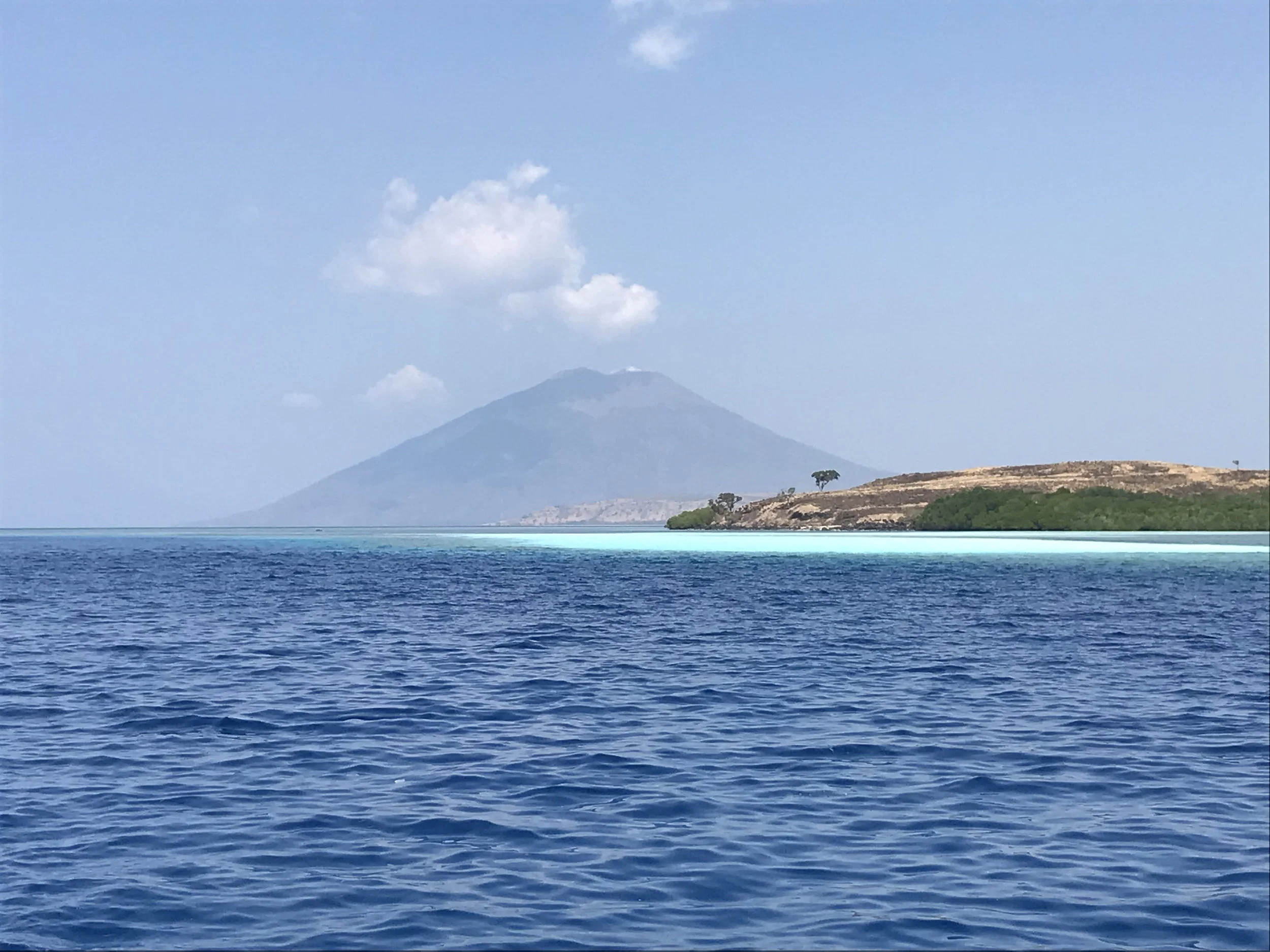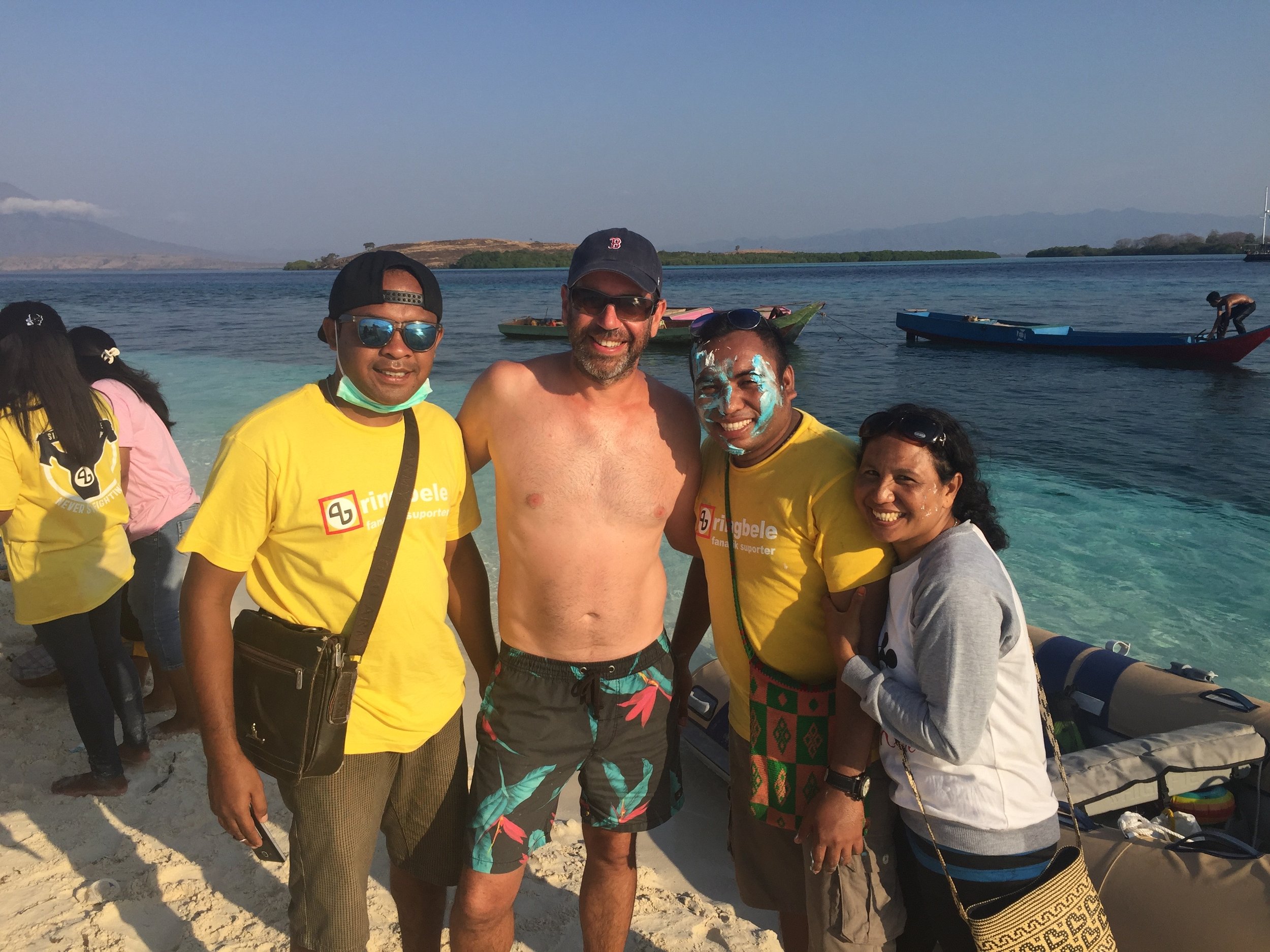The Importance of "unlearning"

We’re anchored in the most beautiful setting imaginable, in a narrow channel of crystal clear water, fringed by spectacular coral reef.
In the middle distance are three volcanoes (one of them lazily smoking), forming a circle around us. And 100 meteres away is a pristine, white, sand-spit, which almost disappears at high tide, and is large enough at low tide for a game of beach cricket.
We’re the only boat around.
Steely at anchor at Kroko Atoll, on the NE side of Adunara Island, Indonesia. The sand spit is just out of shot on the left hand side of the picture.
After a couple of days of relaxing in what has to be the nicest anchorage I’ve ever been in, I decide that I want to give our new drone a workout. I’m still not confident enough to take off and land from the boat, so we decide to go ashore to the sand spit to fly it from there.
As we lower the dinghy and start gathering all the stuff we want to take with us, we notice a long, narrow boat full of locals pull up to the spit and about 20 local kids and teenagers spill out. Another boat follows with a similar number.
Now the sand spit has 40 people or so milling around, and it’s no longer the pristine calm environment we’d been looking at for the last few hours.
No matter we think, it’s there to share, their presence shouldn’t affect our plans, and so we motor the hundred metres or so towards the spit.
As we get closer, the group turns towards us and a few start wading into the water to help us beach the dinghy. Four or five kids, the eldest of whom would have been about 15, start pushing and pulling the dinghy ashore, before we’ve even had a chance to jump out.
As we step onto the sand, the entire crowd gathers around us.
“Mister, mister”, several kids shout. One of them grabs my arm and starts pulling me away from the dinghy.
I look over to Jen and Alan (our friend who is sailing through Indonesia with us), unsure whether to be alarmed or not.
They’re also being dragged away from the dinghy, in my direction.
“Photo, Photo” says the kid holding onto my arm, and immediately places his other arm around me, while one of his friends takes several pictures. Then another teenager appears on my other side, and several more shots are taken.
I look over, and both Jen and Alan are also being individually mobbed, with kids jostling to take selfies with the white folk. There’s a constant rotation of kids, each of them taking it turns to grab my arm, imploring me to take the next picture with them, and their friends.
I feel like a rock star, albeit a middle-aged, slightly overweight, pasty one, with a fixed grin and mildly surprised look on my face. “Where are my minders when I need them” I think.
My next thought is less amusing. I realise that we’ve slowly been creeping down the beach and are now 30 or 40 metres away from the dinghy, which when I last saw it, was crammed full of three sets of snorkelling equipment, fins, cameras and my drone.
I crane my neck to look over the throng, and can see three kids right beside the dinghy.
Are they loitering, playing, or relaxing?” I wonder. I’m unsure, but my every instinct is screaming that this is a trap. We’re being manoeuvred away from our expensive belongings so that the kids can rummage through the boat and steal our stuff.
It’s a hard thought to shake. Partly it’s because the drone is new and expensive, and I’m being precious with it all the time. And partly it’s just common sense that tourists need to be aware of their belongings.
But if I’m honest, there’s also more than a hint of prejudice going on. They’re young, they’re from a different culture, they have a different skin colour, they’re poor. They must be trying to steal from me.
No matter that we’re on a sand spit which is less than 100m long and 10m wide. No matter that everyone is wearing shorts and t-shirts, with literally nowhere to hide masks, fins and snorkels, never mind a large bag with the drone in it.
And no matter that all the evidence right in front of my eyes is that these are the loveliest, friendliest people I could ever hope to meet, and that they’re simply thrilled to have the chance to have a photo taken with me.
I succumb to the experience, and after fully 30 minutes of photo taking, and no sign of it abating, all three of us seem to reach the point of saying “enough” at the same time, and the mayhem calms down a little.
I did get to fly the drone eventually. This is after the mayhem of the picture taking had died down.
We have a chance to speak to them a bit, and a few have quite reasonable English. They’re from a nearby village, and it’s the birthday of one of them. Someone produces a cake and a rousing rendition of “happy birthday” is sung in English . And then, as the guests of honour, Jen, Alan and I each have to have some cake before the others will.
A rousing rendition of “Happy Birthday”
It was the most amazing experience, and something that I’ll remember for the rest of my life.
But it also was our first confrontation with a thought that has recurred continuously throughout our time in SE Asia so far.
They’re poor. We’re (comparatively) rich.
We anchor outside their village in our shiny yacht, we don’t speak the language, and we’re always looking for something.
They’re bound to want to rip us off, right? Or steal something from the boat while we’re ashore?
Nope, they’re unfailingly polite, helpful and friendly. Whether it’s a casual wave, a shy smile, or a genuine offer to help, every single experience (with just one exception) has been positive.
What about going through Customs, Immigration, Quarantine in third world countries with a reputation for corruption? Polite, courteous and helpful in every situation.
Like most of us, I learned to be cynical about people in our sanitised, western, 1st world environment, where we’re taught to be scared of “the other” – skin colour, culture, ways of life etc.
It turns out I have a lot to unlearn!
This post is one of a series of 10 insights and learnings from the first 12 months of our circumnavigation. Click here to see the full list and access the other posts.








